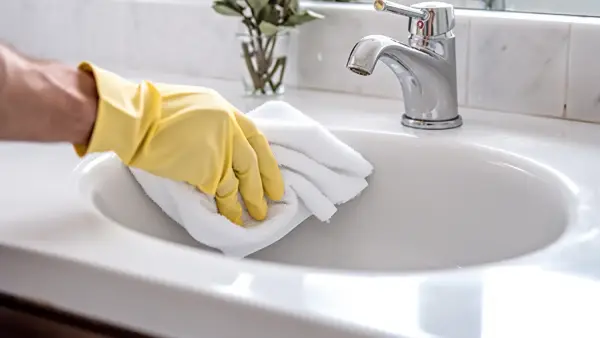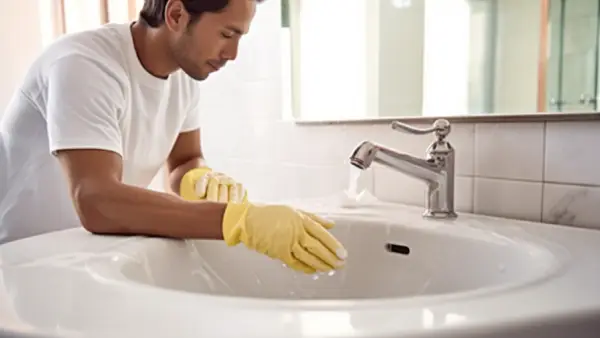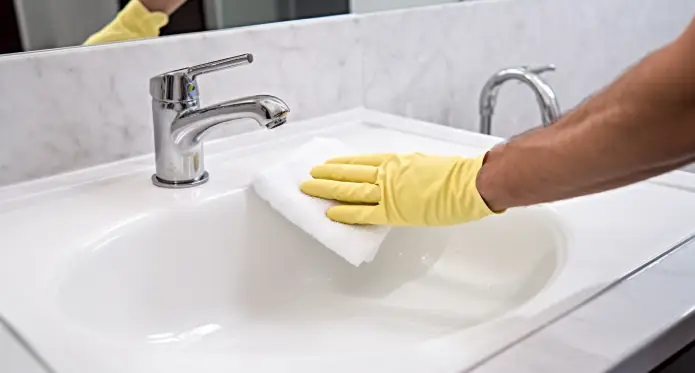Last Updated on November 14, 2023
Your bathroom sink can develop scratches and damage over time due to regular wear and tear. These scratches make your sink look unsightly and a fertile environment for bacteria and mildew. But with the right tools and know-how, repairing scratches on your bathroom sink is simple.
To begin with, evaluate the extent of damage inflicted upon the sink’s surface. After that, gently clean using mild soap to eliminate accumulated dirt and grime. A rubbing compound will instead be suggested for more stubborn imperfections. For deeper scratches, employ a porcelain repair kit.
With the help of this article, we’ll explain what to do if you have scratches and stains from your bathroom porcelain sink so it looks brand new again. So keep reading for more information.
How to Remove Scratches From Porcelain Sink in Bathroom: Steps You Can Follow

If you have scratches on your porcelain sink in the bathroom, there are 6 steps to remove them.
- Assess the Damage
- Clean the Sink with Mild Soap
- Use Baking Soda for Lighter Scratches
- Consider Rubbing Compound
- Try the Porcelain Repair Kit (For Deeper Scratches)
- Apply Wax to the Sink (optional)
Now, let’s take a closer look at these steps:
Materials You’ll Need
- Soft cloths or sponges
- Baking soda
- Hydrogen peroxide
- Acetone or nail polish remover (non-acetone)
- Rubbing compound
- Porcelain repair kit (optional)
STEP 1. Assess the Damage
Before you begin the process, closely examine the damage on your porcelain sink. Inspecting the sink will help you determine the severity of the scratches and the necessary course of action.
If they’re shallow and only affect the top layer of the porcelain, you can buff them out using a mild abrasive cleaner or toothpaste. However, consider a more intensive repair method if the scratches are deeper and more pronounced.
STEP 2. Clean the Sink with Mild Soap
Grab a soft cloth or sponge and warm, soapy water to clean the sink thoroughly. The warm, soapy water will help to break down any dirt, grime, or residue that may be present on the sink.
Gently scrub the entire sink, paying close attention to the areas where the scratches are located. Rinse the sink well with clean water to remove any soap residue.
STEP 3. Use Baking Soda for Lighter Scratches
Now, tackle lighter scratches on your porcelain sink using baking soda. Add a little water to baking soda to make a paste that is thick, spreadable consistency. Once the paste is ready, apply it to the scratched surface and gently scrub it using a soft cloth or sponge.
As you rub, add more paste and water as needed to maintain consistency. After a few minutes of rubbing, rinse the sink thoroughly with water to remove any residue from the baking soda.
STEP 4. Consider Rubbing Compound for Minor Scratches
If you’re still unsatisfied with the results, try using a rubbing compound to remove scratches from your porcelain sink. Rubbing compound is a slightly abrasive substance that can help buff out deep scratches. Apply a small amount of rubbing compound, such as KOHLER cast iron clean, onto a soft cloth.
Then, gently buff the scratch area in circular motions. Use even pressure and prevent rubbing too vigorously, as this could damage the sink’s surface. Once you’ve completed buffing, wipe off any residue with a clean cloth and rinse the sink thoroughly.
STEP 5. Try the Porcelain Repair Kit (For Deeper Scratches)
For deeper scratches, you should consider trying a porcelain repair kit. These kits, such as the HIMG or Rohl porcelain repair kit, are designed to fix deep scratches and chips in porcelain surfaces.
They come with all the necessary materials and instructions to help you fill in the damaged area and restore the appearance of your sink. The process is relatively simple, but it requires careful attention to detail.
Clean the damaged area thoroughly and remove any loose debris. Then, mix the repair compound according to the manufacturer’s instructions and apply it to the scratch using a provided applicator or a small brush. Allow the compound to dry completely before gently sanding it to a smooth finish.
STEP 6. Apply Wax to the Sink (Optional)
Once you have successfully removed the scratches from your porcelain sink, applying wax or polish is a good idea to enhance its appearance further. The wax acts as a protective layer, preventing new scratches and stains from forming. It also adds a glossy finish, giving your sink a beautiful shine.
Before applying the wax, clean the sink thoroughly and dry it completely. Follow the directions on the product carefully, applying a thin and even layer of wax using a soft cloth. Allow the wax to dry thoroughly before wiping it with a clean cloth to achieve that perfect shine.
What Else Can You Use to Clean Your Bathroom Porcelain Sink Stains?

If you’re looking for alternative ways to remove stains from your bathroom porcelain sink, try a few options.
1. Toothpaste (Non-Gel)
You can use non-gel toothpaste (preferably with baking soda or whitening properties) to remove stains from your porcelain sink. Non-gel toothpaste is a great option for removing minor scratches and stains because it contains abrasive particles that help to scrub away dirt and grime gently.
2. Hydrogen Peroxide
Hydrogen peroxide is known for its mild bleaching and cleaning properties, making it a great option for tackling stubborn stains. When using hydrogen peroxide, gently rubbing the stained areas with a cloth or sponge will remove the stains.
3. Rubbing Alcohol
Rubbing alcohol is an effective solution for removing tough stains and residue from your sink. It can easily dissolve and break down various substances, making it a great choice for tackling stubborn marks.
4. Acetone or Nail Polish Remover (Non-Acetone)
Using acetone or non-acetone nail polish remover can remove stains and scratches from your bathroom porcelain sink. These products contain solvents that can break down and dissolve tough stains like ink or other stubborn marks.
Acetone and non-acetone nail polish removers are readily available and can be found at most drugstores or beauty supply stores. They’re a convenient and affordable solution for removing stains from your porcelain sink, leaving it clean and pristine.
Do bathroom porcelain sinks scratch easily?
Bathroom porcelain sinks don’t scratch easily, so you don’t have to worry too much about damaging them. Unlike other materials like stainless steel or acrylic, porcelain is a hard and durable material that can withstand everyday use without showing signs of wear and tear.
However, while porcelain sinks aren’t prone to scratches, they can still accumulate gray or black marks on the bottom. These marks may resemble scratches, but they can be easily removed with the right cleaning products and a little effort.
Can I repair scratches in the bathroom porcelain sink?
A porcelain repair kit can easily fix unsightly scratches and minor cracks in your sink. These kits usually have an abrasive cloth to buff the nick and surrounding area and a gloss or glaze to fill the damaged spot.
The best part is that you can find a finish that matches the color of your sink, ensuring a seamless repair. Regardless of whether or not you have experience in repair, the process is straightforward.
Transform Your Bathroom Sink From an Eyesore to a Beautiful Centerpiece
A scratched sink can detract from the beauty of a bathroom and make it look unappealing. But with the help of our step-by-step guide, you can restore its appearance and functionality.
Whether you have minor or severe surface scratches, apply the recommended cleaning products to ensure your sink’s longevity and keep it looking new. All the recommended products are easily available at your local hardware store or online, so try it yourself.
Be aware porcelain sinks are durable but can still scratch easily, so be mindful when cleaning and avoid using abrasive materials.

